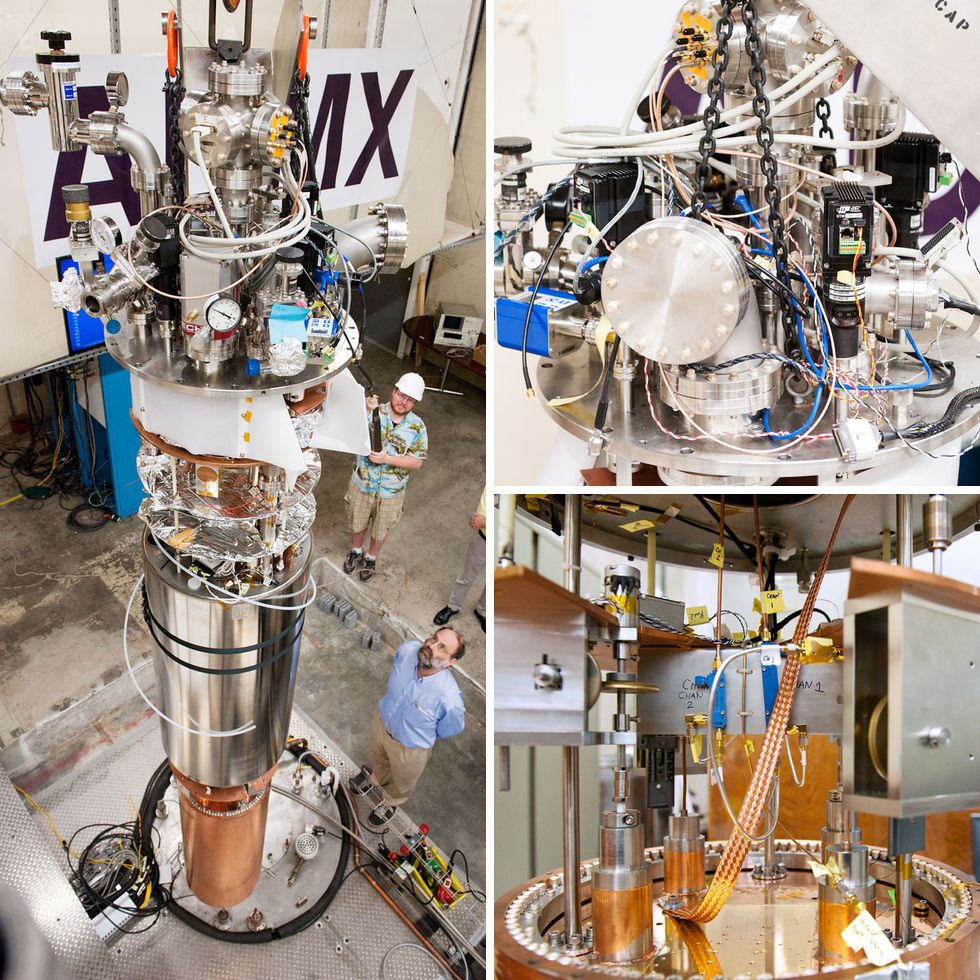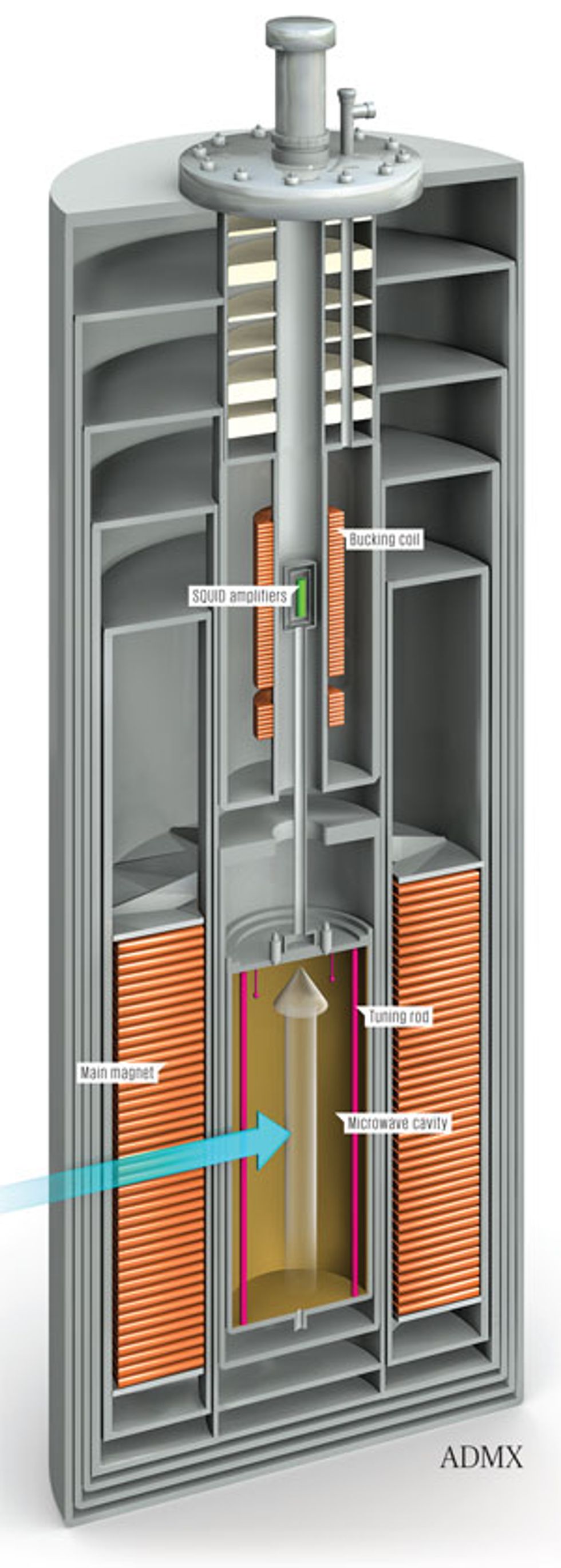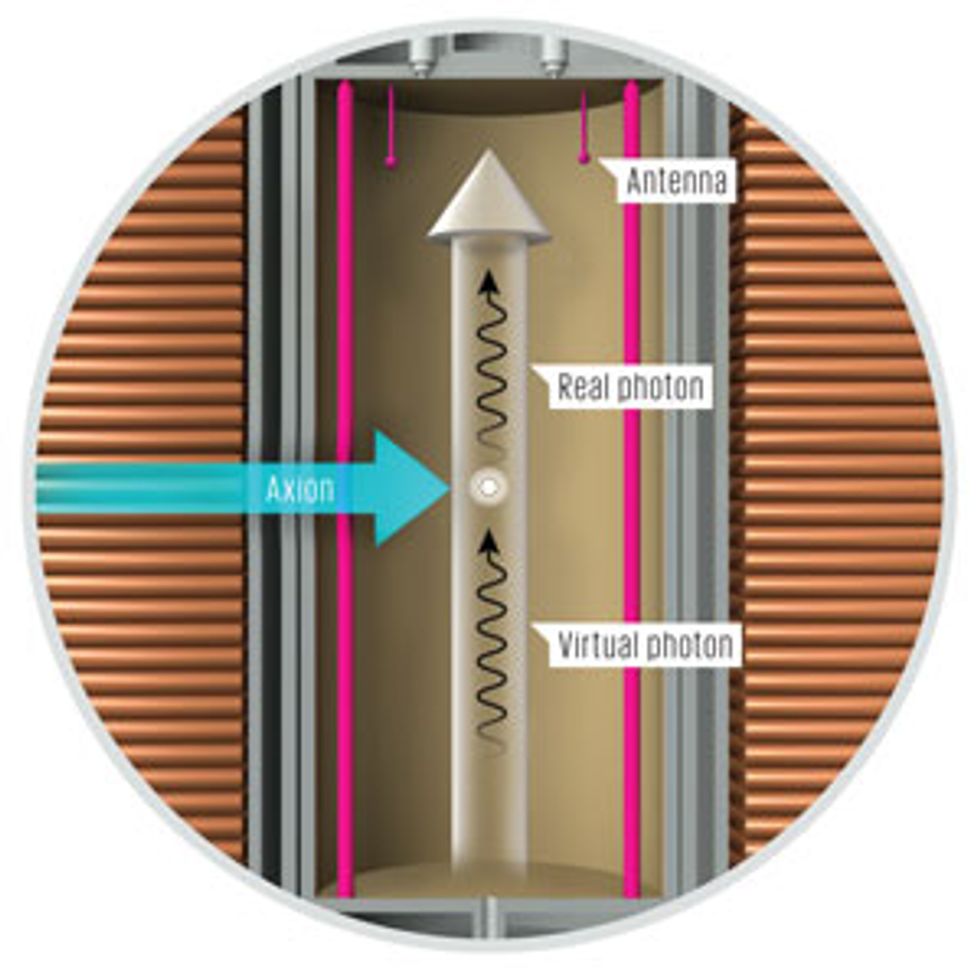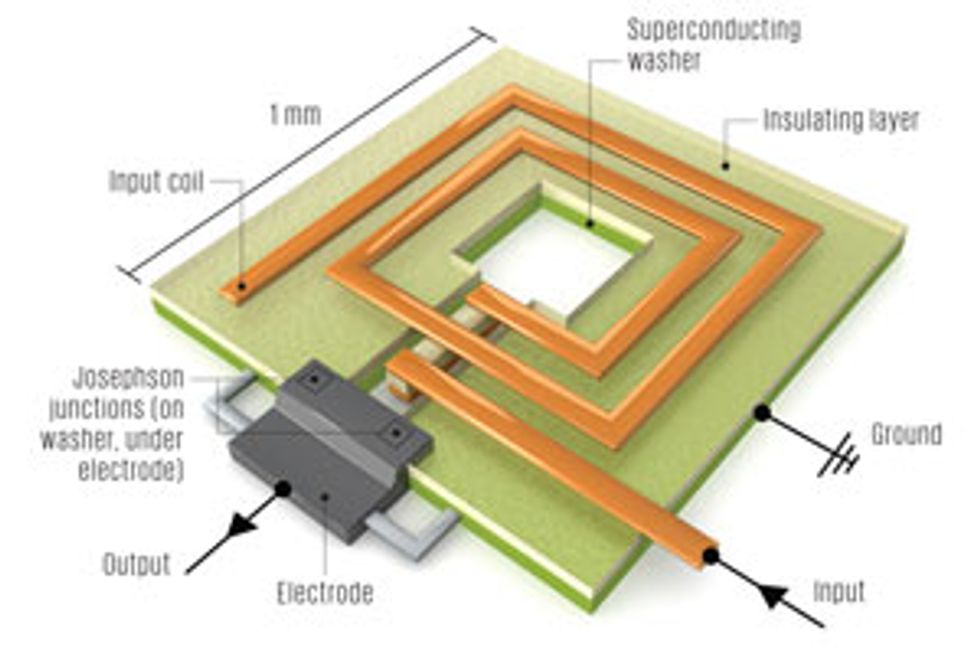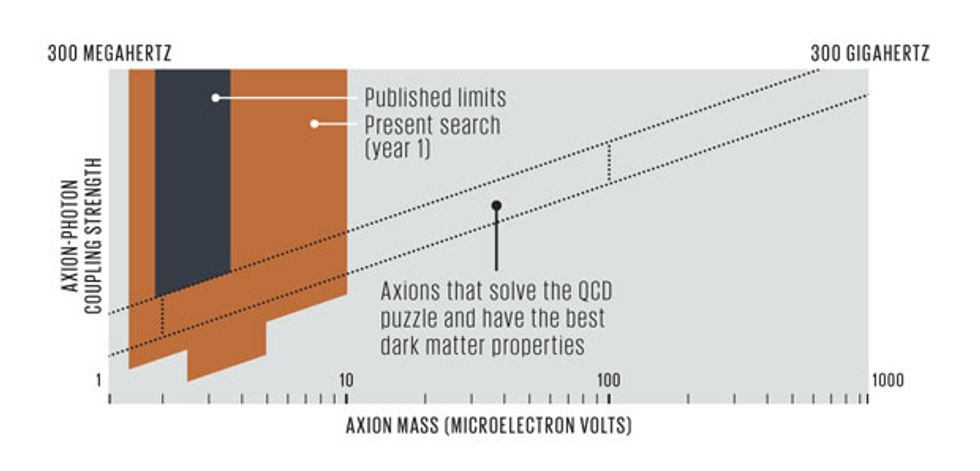The Hunt for the Invisible Axion
One team goes it alone in the quest for the dark horse in the dark matter race
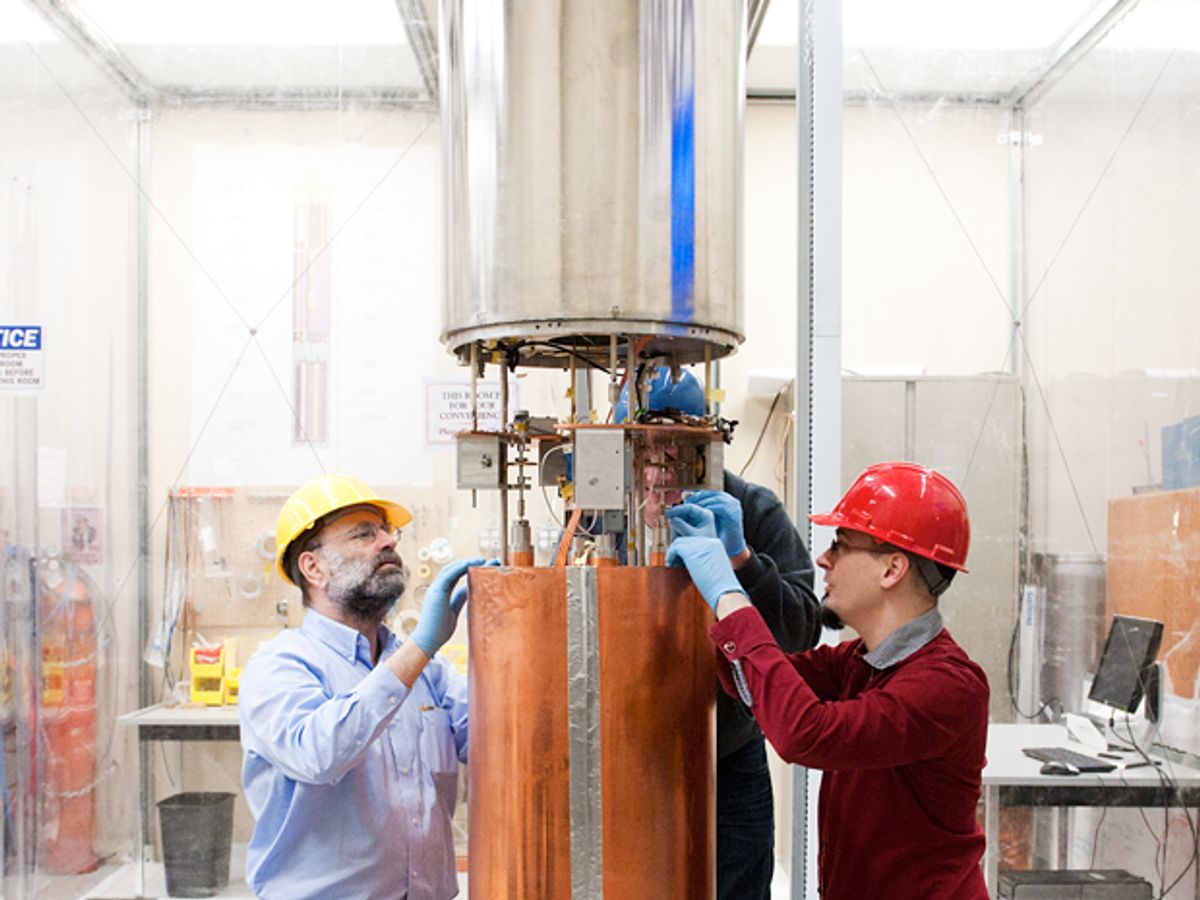
Dark matter, the most abundant form of matter in the universe, is invisible and intangible. But that doesn’t keep Leslie Rosenberg from seeing it nearly everywhere he looks. Like most physicists, he finds ample evidence of it written on the sky. It’s there in the swirling of galaxies, the aftermath of cosmic collisions, and the vast, weblike scaffolding that the universe’s luminous matter seems to hang upon.
It’s also, he hopes, near at hand. Dark matter almost certainly sweeps through Earth like water through cheesecloth. But Rosenberg, a professor at the University of Washington, in Seattle, thinks he might have just the thing to coax it out of hiding.
Tucked into the concrete floor of a large warehouselike laboratory at the edge of campus, the Axion Dark Matter eXperiment (ADMX) contains the world’s most sensitive radio receiver in its frequency range. Its builders are fond of boasting that if the detector were placed on Mars, it could pick up a cellphone signal sent from Earth, assuming there were no interference.
It’ll need that kind of sensitivity to have any chance of detecting dark matter. Based on a wide range of observations going back to the 1930s, astronomers estimate that for every kilogram of ordinary matter in the universe—be it hydrogen, silicon, concrete, or feathers—there are some 5 kilograms of dark matter. But for all its ubiquity, no one knows what the dark stuff is made of. They only know that, with the exception of exerting a gravitational pull, it interacts very little with ordinary matter.
ADMX is designed to hunt for one of the leading dark matter candidates: the axion. And now, after some 25 years of development, Rosenberg and his colleagues may be on the verge of finally seeing the elusive particle—if it does in fact exist. Later this year, a new cryogenic cooling system will chill the ADMX detector down to just a tenth of a degree above absolute zero, bringing the experiment to its peak sensitivity. Over the coming months and years, the detector will scan radio bands in the hopes of literally tuning into dark matter’s wavelength, converting axions into electromagnetic radiation that can be picked up and amplified through sensitive quantum electronics. Any day now, finding dark matter could just be a matter of hitting the right frequency, says collaborator Gianpaolo Carosi, a research scientist at Lawrence Livermore National Laboratory, in Livermore, Calif. “We’re trying to look for that little tone above the hiss.”
Nowadays, thanks to a range of complementary observations of the universe, a consensus has emerged over its composition. Astrophysicists estimate that if you count all the mass and energy contained in the cosmos, ordinary matter—all the gas, dust, stars, and planets—makes up only 5 percent of the total. The rest is divided between two unknown entities: dark energy and dark matter.
Dark energy—which seems to be some sort of vacuum-filling field that forces space apart—is the more recent discovery. The first hint of it was detected in 1998, when astronomers used the brightness of exploding stars to gauge cosmic distances and, by extension, the universe’s recent expansion history. They found that today the universe is not only expanding, it is expanding at an accelerating rate.
Dark matter is a much older puzzle. Its presence was first revealed in the 1930s, when astronomer Fritz Zwicky measured the speeds of eight galaxies in the nearby Coma cluster and found that they were moving far too quickly to be bound by the gravity of the cluster’s luminous matter. Zwicky concluded that some extra, unseen mass must be present to keep the galaxies in tow.
Since then, evidence of dark matter has cropped up in many other places. Some astronomers contend that what seems to be extra mass is actually evidence of a breakdown of gravitational laws on large scales. But for many researchers, the observations clearly point toward an entirely new particle. Finding it would be a major milestone in our effort to understand the fundamental physics of the universe.
The axion is just one of a host of dark matter candidates that have been proposed over the years, including very small black holes, formed moments after the big bang. Nowadays, many consider the leading candidate—and the axion’s main rival—to be the weakly interacting massive particle, or WIMP, a hypothetical heavyweight that could have a mass hundreds of times that of the proton. WIMPs aren’t like ordinary matter; they don’t respond to electromagnetic fields or give off light. Instead, they interact only through gravity and the feeble weak force, most famous for causing some atoms’ neutrons to decay into protons.
The WIMP most heavily favored today is tied to the theory of supersymmetry, a potential extension of the standard model of particle physics that could explain why ordinary particles have the range of masses they do. Supersymmetry predicts a new family of particles more massive than those we see around us. The lightest of those could have been created in large enough quantities in the early universe to account for dark matter. Such a particle could also act as its own antiparticle, so that when two collide, they annihilate, releasing particles such as photons in the process.
The WIMP hunt is wide. Some researchers look for evidence of the particle’s creation in data from the Large Hadron Collider. Others scrutinize the Milky Way’s gamma-ray glow for light that would be produced when WIMP pairs annihilate. Year after year, ever-larger and more-sensitive detectors are built in the hopes of capturing WIMPs as they pass through Earth. To isolate these detectors from confounding signals produced by particles zipping through Earth’s atmosphere, the experiments are hidden inside mountains and former mines and down boreholes in Antarctic ice.
There, like enormous catcher’s mitts, the detectors lie in wait for extremely rare collisions between one of these lumbering phantasms and an ordinary atom. Such a collision would cause the atom to recoil, raising a small vibration. In some cases, electrons and photons would be released. These sorts of effects can be picked up with light- and charge-sensitive detectors. The hope is that, over time, the infinitesimal energy released by that occasional bump might just add up to a signal that’s consistent with an entirely new particle. In this hunt, seasonal variation will be key, as the flux of dark matter particles will change depending on where Earth is in its orbit.
“We have something like 20 different experiments out there that are designed to look for WIMPs,” says Dan Hooper, a physicist at the Fermi National Accelerator Laboratory, in Batavia, Ill. Recently, astrophysicists looking toward the center of the Milky Way have found a peculiar spike in intensity at a particular frequency in the gamma-ray part of the spectrum. The signal looks more and more WIMP-like year after year, Hooper says, but terrestrial detectors have yet to turn up any hard evidence of WIMPs, and recent results have “dampened enthusiasm.”
Last year, for example, physicists put the finishing touches on the most sensitive such detector yet built, the Large Underground Xenon experiment, which contains some 350 kg of liquid xenon. In the first three months of its hunt beneath the Black Hills of South Dakota, the detector turned up no evidence of WIMPs, knocking down a few models and contradicting hints seen in prior experiments.
Against all this effort, there is ADMX, the only experiment looking for the other leading dark matter candidate: the axion. Compared with the WIMP, the dark matter axion is staggeringly ethereal. At most it would be just a trillionth the mass of the proton, much too light to register in the recoil of atoms, as WIMPs are supposed to. To provide the same gravitational heft, dark matter axions would have to be present in much higher numbers than WIMPs would. Trillions of them would occupy each cubic centimeter of our corner of the galaxy. But detecting even a few of those particles will be a challenge, requiring highly sensitive electronics that generate very little noise of their own.
Over the years, Rosenberg says, he has encountered sometimes strong resistance to the idea that ADMX could ever be sensitive enough to see an axion signal. Now, with the WIMP still elusive and ADMX’s hunt under way, he sees the tide turning. On a visit to Seattle, I ask him over sandwiches what the WIMP community thinks of ADMX. He grins. “They’re thinking, ‘Are those pigs going to find a truffle?’ ”
The axion was not devised with dark matter in mind. The idea for the particle first emerged in the late 1970s, in an effort to solve a different puzzle relating to quarks and gluons. According to the standard model of particle physics, every proton and neutron consists of three quarks, which are held together by gluons. Quarks and gluons behave extraordinarily symmetrically: Swap a particle for its antiparticle and reverse the spatial coordinates and you’ll get the same behavior. This is surprising because the theory that describes how quarks and gluons interact—quantum chromodynamics—could easily violate these symmetries. These violations should be apparent in the neutron’s electric dipole moment—a measure of the electric field that would arise if the positive charge inside the neutron resided closer to one end of the particle and the negative charge closer to the other. But to the limit of their experiments, physicists detected no evidence of such a moment, suggesting a high degree of symmetry, one that was quite unlikely to occur by chance.
In 1977, two physicists at Stanford University, Roberto Peccei and Helen Quinn, published a paper proposing a solution: an additional field that would pervade space and, like a kind of gravity, provide a mechanism for the universe to essentially “tilt” naturally into a symmetrical state. Hot on their heels, physicists Steven Weinberg and Frank Wilczek each published a paper pointing out that the existence of a field implied a corresponding particle. Wilczek, thinking of a once-popular brand of detergent, already had the perfect name in mind for something that could clean things up so nicely: the axion.
When the axion was first proposed, particle physicists looked for it in particle colliders. But the axion did not emerge, and theorists concluded that if the particle did exist, it must be too light and interact too rarely with matter to appear in such collisions. Around the same time, Wilczek and others realized that this new, more ethereal version of the particle could have been created in large enough numbers in the early universe to account for dark matter.
How to find it? Wait long enough and an axion will naturally decay into two photons. But that process would take 1050 seconds or more. That’s about 1032 times as long as dark matter axions (and the rest of the universe, for that matter) have been around.
“The axion had been declared invisible,” says theorist Pierre Sikivie. “[I said], let me just calculate how invisible they truly are.” A newly minted professor at the University of Florida in the early 1980s, Sikivie had just finished teaching his first graduate-level electromagnetism course and was hunting for a juicy physics problem to work on.
Producing an axion in a collider was already a low-probability event. Detecting that axion would be another low-probability event, compounding the problem. But Sikivie found there was a reasonable hope of finding axions that already exist. In a 1983 paper, he outlined a scheme that might work: exposing the particles to a very strong magnetic field. This field would create a sea of “virtual photons”—packets of electromagnetic energy that flit in and out of existence due to quantum mechanical variations in vacuum. By the same rules that cause an axion to decay into two photons, a virtual photon could be used to trigger the conversion of an axion into another photon.
The trick would be to create virtual photons with the axion’s frequency: Axions, like all other particles in quantum mechanics, are also waves and so have a corresponding wavelength and frequency.
“If the dark matter is axions, then we are surrounded by this field that is oscillating at a frequency given by the axion mass,” Sikivie explains. On its own, a strong magnetic field creates a host of virtual photons, but with a range of different frequencies. Because only a small number of those photons would match the axion frequency, few would trigger an axion conversion. But Sikivie reckoned he could boost the chance of conversion using an electromagnetic cavity with a high quality factor. In such a cavity, electromagnetic radiation at a particular resonant frequency bounces back and forth with little loss, like sound waves in an organ pipe.
Thanks to some quantum mechanical magic, this setting would create a high population of virtual photons with frequencies that matched the cavity’s resonant frequency. If an oscillating axion field matched this frequency, an axion could be converted into microwave radiation with that same frequency. The cavity could then amplify that signal.
“All of us were smitten, I think, by the elegance of that idea,” says Karl van Bibber of the University of California, Berkeley. Within a few years, two teams—one based at Brookhaven National Laboratory, in Upton, N.Y., and the other at the University of Florida, in Gainesville—had built small, tabletop-class metal cavities to test the concept. One thing the researchers had to prove is that such cavities could tune their resonant frequency. Because the mass—and thus the frequency—of the axion was unknown, the detectors would have to sweep through a large swath of the radio spectrum until they hit upon the frequency that would call axions out of hiding.
The teams showed that you could use rods, moved in from the edge of the cavity or out from the center, to alter the interior of the cavity and so tune its resonant frequency over a fairly wide range. But the experiments fell short of the sensitivity needed to see the axion at even its most optimistic interaction strengths. At the very least, the researchers found, they’d need stronger magnetic fields to boost the probability of converting axions into photons. Bigger cavities, which would expose more axions to the magnetic field at any given moment, would also help.
Flash forward to 1989. Van Bibber, who was then working at Livermore, found he’d been volunteered for the task of building the next axion detector. So ADMX—although it wasn’t yet called that—began its earliest incarnation there, in an old hangar with no climate control and temperatures that could top 45 °C in the summer.
To create the magnetic field needed to convert the axions, in 1995 van Bibber and his team purchased a 6-metric-ton, 1-meter-tall superconducting magnetic coil. They designed an insert to go inside this coil—an empty copper-plated stainless steel cylinder about the size of an oil drum. A set of motor-controlled tuning rods would be inserted into the cylinder to control the resonant frequency, along with a simple wire antenna to pick up the microwave signals. A chain of ultralow-noise, transistor-based amplifiers would boost this signal and send it to signal processing equipment: a series of mixers and filters to bring the signal frequency down to audio frequencies. The signal would then be converted into a power spectrum by using a fast Fourier transform. Over time, as the detector moved through frequencies, data showing power as a function of frequency would accumulate. If the axion were found, it would appear as a simple spike in the spectrum, rising above the noise.
By 1996, construction was well under way. Even then, the team knew that although their detector could see some kind of axion, it wouldn’t be sensitive enough to do a thorough search. In a year they could search a small, 100-megahertz chunk of the microwave spectrum. Even within that window, the detector would be sensitive only to an axion that had a relatively strong interaction with electromagnetic fields and thus a high chance of converting into a photon. There was the possibility that the dark matter axion might have a much weaker “coupling” to electromagnetic fields and so a very low chance of converting.
To find an axion with the weakest of couplings in that same range, they’d have to sit on each frequency for much longer. The search might take 50 years, or even more. Physicists beginning the hunt fresh out of graduate school probably wouldn’t see the end of it before they retired. To detect the most weakly interacting axions, the system would need to be sensitive to power as low as a yoctowatt, a trillionth of a trillionth of a watt. That’s about a thousandth the power of the last signal received on Earth from Pioneer 10, when the spacecraft was some 12 billion kilometers away, long past the orbit of Pluto.
“We were scratching our heads about how to speed things up,” Rosenberg says. For the initial signal amplification, the team was already using what might be considered the gold standard: high-mobility, heterojunction field-effect transistor amplifiers. To keep the noise to a minimum, these were cooled to just a few degrees above absolute zero. But they’d need something even quieter to speed up the search.
Fortunately, by the late 1990s, the team had found John Clarke. A physicist at UC Berkeley, Clarke was working on superconducting quantum interference devices, or SQUIDs, which each consist of a loop of superconducting material interrupted by two Josephson junctions. Minute changes in the magnetic field passing through the loop will register as a voltage that can be detected using conventional electronics.
After a workshop at Livermore, Clarke told the ADMX team that a SQUID could, in principle, be used to amplify an axion signal with far lower noise—about a fortieth that of high-electron-mobility transistor amplifiers. That would mean a speedup of about a factor of 1000 in the experiment’s scan rate. But there was a catch: To be sensitive to axions, the SQUIDs would have to be made to work at frequencies extending beyond a gigahertz. That was well above the frequency range of a typical SQUID at the time, which topped out at about 100 MHz.
The obstacle was parasitic capacitance. Signals enter a typical SQUID as current in a superconducting coil, which is separated by an insulating layer from the SQUID washer—the part of the device that contains the loop and Josephson junctions. In ordinary operation, the washer picks up the magnetic field created by the coil. But at high frequencies, the capacitance between the coil and washer saps a signal’s power instead of amplifying it. Michael Mück, a researcher in Clarke’s lab, found that an adaptation to the input coil would fix the problem. He made it so the far end of the coil would dangle unattached instead of going on to form a complete circuit. A signal coming into the coil would bounce off this end. If the signal had the right wavelength, a standing electromagnetic wave would arise between the coil and the washer, a resonance that would amplify the signal. “This trick makes a virtue out of what was formerly a parasitic capacitance,” Clarke says.
By 2003, the team had high-frequency SQUIDs in hand, and they had started building a new insert for ADMX that would incorporate one of them to amplify signals from an antenna. But the experiment would have to go a bit slower than expected. To get the most out of a SQUID, the experiment’s temperature would have to be lowered to 100 millikelvins—a tenth of a degree above absolute zero. ADMX’s previous incarnation had run at 1.3 kelvins at its lowest.
So how much trouble could a measly degree and a quarter kelvin cause? Plenty. The team would need to add new cryogenic equipment to get down to 100 mK. But the U.S. Department of Energy deemed that integrating SQUIDs into the experiment was a “high technical risk” all by itself, Rosenberg says. The team had to ensure they could isolate the exceedingly sensitive device from all external magnetic fields while installing it near the coil of a superconducting electromagnet with a magnetic field strength of 8 teslas—more than double what’s seen in a typical MRI machine. “The SQUID would just get wiped out in the Earth’s magnetic field, let alone our field,” he says. As a result, the experiment was split into two phases. The first (Phase 1) would integrate the SQUID, and the second (Phase 2) would cool the experiment to its ultimate temperature.
To isolate the SQUID from all external magnetic fields, the team settled on a configuration that put the amplifier about a meter above the magnet’s coil. They built an onionlike enclosure with a set of layers designed to block out the magnetic field. The most crucial of these was a pair of counterwound superconducting electromagnets, called a bucking coil, that would cancel out the magnetic field created by the main coil. The design had to be carefully done; because the bucking coil sits in a region where the magnetic field strength is changing dramatically from point to point, there would be tons of force on it. “The mechanical tolerances aren’t exquisite, but they can’t be pooh-poohed,” Rosenberg says. “You make a centimeter error and the bucking coil would rocket out of the experiment.”
After a somewhat nail-biting start, the SQUID amplifier was installed, and by 2006 the first phase was complete. The team showed that SQUIDs could work well in the high-magnetic-field environment. By 2010 the experiment had been dismantled, and magnet and cavity were strapped to the back of a flatbed truck. These components followed Rosenberg from Livermore to the University of Washington, where Phase 2 recently got under way.
In October of 2013, when I visit the Seattle team, Rosenberg takes me on a circuitous tour past snaking cables, jumbles of equipment, a small particle accelerator, and an imposing-looking Faraday cage. ADMX, which sits at the far end of a massive gray experiment hall, looks dwarfed by its surroundings. Most of its hardware, including its giant superconducting coil, is tucked down in the floor to give researchers easy access to all the valves and electronics at the top. Billowing clouds of water vapor condense around the area where liquid nitrogen is being piped into the experiment—the first step in bringing temperatures inside the detector down to a hair above absolute zero.
The team has since started scanning for axions, but ADMX is still awaiting one major component: a dilution refrigerator, which will use a mix of helium-3 and -4 to bring the temperature of the experiment down to 100 mK. At that point, Livermore’s Carosi says, “the experiment will be at its ultimate sensitivity.” The low temperatures will push the noise of the two SQUIDs in ADMX’s present incarnation down close to the minimum. It will also lower the amount of radiation created by the cavity itself. Like any object with a temperature, the cavity walls naturally produce some electromagnetic radiation, and here the bulk of it will be at microwave frequencies. That radiation creates noise that, if not minimized, could swamp the signal of a handful of axions-turned-photons.
ADMX is now poised to scan for axions at a speed about 1000 times as fast as when it first started, allowing the team to cover large swaths of the spectrum in a matter of years. “This is what we call the definitive search,” Rosenberg says when we sit down in his office for a break after visiting the lab. “If it’s there, we’ll find it.”
But it’s not quite as simple as that. There is a lot of ground to cover. Physicists have put upper and lower limits on the possible mass of the dark matter axion based on astrophysical observations. If the hypothesized particle mass is too low, too many of them would have been created in the moments after the big bang, producing more dark matter than we know to exist. On the other hand, if the mass is too high, it would affect the physics of stars, providing supernovae with another channel by which energy could be released. This would cool the explosions and allow particles like neutrinos, which bounce around repeatedly in the expanding stellar remnants, to escape more readily.
Even with those bounds, there is still a factor of 1000 in mass—and therefore a factor of 1000 in frequency—that the dark matter axion hunt must cover. ADMX will start at the bottom, around 300 megahertz, representing the lowest-possible-mass particle, and work its way up. The team hopes to cover the first “decade,” or factor of 10, in frequency in a year or so and then, with some modifications to the cavity size and the electronics, make a good dent in the second decade.
That will allow the team to cover a large chunk of the range occupied by the “best-motivated” axions, those with properties most favored by astrophysical observations and particle physics theory. But covering the complete range of possible dark matter axions will be a challenge, especially when it comes to the last decade in frequency, which spans 30 to 300 gigahertz. When the experiment reaches frequencies of 10 GHz or so, the cavities would have to be quite small, about the size of saltshakers, Carosi says. A smaller cavity will catch fewer axions. To make up for the smaller volumes, the team would have to find ways to create large arrays of these tiny cavities. They’d have to make robotic motors capable of tuning them all to the same frequency at the same time, so they could be used in concert to look for an axion at a given mass. “That can really get quite unwieldy,” van Bibber says. Both he and Carosi, in collaboration with a team at Yale University and the University of Colorado, Boulder, are exploring what can be done to extend the experiment to higher frequencies. It won’t be easy. “A couple of decades into a venture like this, you get afflicted with these night thoughts about whether there’s a there there,” says van Bibber. “But I’m optimistic.”
But even if ADMX manages to hit every note, from 300 MHz to 300 GHz, there is the possibility that the dark matter axion could be hiding elsewhere. Frank Wilczek, one of the two physicists who first proposed the axion, notes the possibility that dark matter is inhomogeneously distributed in the universe on very large scales and that our particular patch might just have relatively little. If that’s the case, axions might have been created in even higher amounts than our observations suggest. That would mean the particle could be quite light, potentially well outside the window in which ADMX—or any other experiment of its ilk—might hope to see it.
Wilczek says he admires the ingenuity of the ADMX team. “It’s a brilliant experiment, and I hope they find it. It deserves to be true,” he says. “But nature gets the last word.”
This article originally appeared in print as “Getting on Dark Matter’s Wavelength.”
